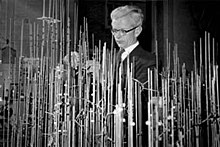John Cowdery Kendrew
Sir John Cowdery Kendrew (born March 24, 1917 in Oxford , † August 23, 1997 in Cambridge ) was a British biochemist, molecular biologist and Nobel laureate in chemistry .
life and work
Kendrew was the son of Professor (Reader) of Climatology at Oxford Wilfrid George Kendrew and the art historian Evelyn May Graham Sandburg. He attended Clifton College in Bristol and studied from 1936 at Cambridge University (Trinity College). In 1939 he earned his bachelor's degree in chemistry. During World War II he was in radar research and operations research for the Royal Air Force, for which he received the honorary rank of Wing Commander of the RAF. After the war he wanted to get into protein research and in 1945 he went to Max Perutz in Cambridge ( Cavendish Laboratory ), where he began to work on X-ray structure analysis of proteins of the hemoglobin family. He became a fellow of Peterhouse College in 1947 and received his PhD in 1949. He did research for the Medical Research Council (MRC) and became a reader at the Davy-Faraday Laboratory of the Royal Institution in London in 1954 .
In 1958 he clarified the three-dimensional structure of myoglobin with the help of X-ray structure analysis . This was made possible by the solution of the phase problem in X-ray structure analysis by Max Perutz in 1953. The elucidation of the structure of myoglobin by Kendrew was the first X-ray structure elucidation of a protein and took place in Cambridge at the later Medical Research Council Laboratory of Molecular Biology . In 1959, Perutz followed hemoglobin in 1959.
From 1962 on he was Vice Director of the Medical Research Council Laboratory of Molecular Biology at Cambridge University and from 1974 to 1982 head of the European Molecular Biology Laboratory in Heidelberg , which he helped to found in 1963. From 1981 to 1987 he was President of St. John's College , Oxford, to which he also left £ 15 million in his will. The Kendrew Quadrangle is named after him in college.
He founded the Journal of Molecular Biology and was its editor for a long time. From 1974 to 1979 he was a trustee of the British Museum and he was president of the International Council of Scientific Unions .
Awards and memberships
In 1962 he received the Nobel Prize in Chemistry together with Max Ferdinand Perutz . In 1964 Kendrew was elected to the American Academy of Arts and Sciences , in 1965 he was awarded the Royal Medal of the Royal Society for his contributions to the elucidation of the protein structure of myoglobin . He is a CBE and a Fellow of the Royal Society.
Kendrew was a member of the German Academy of Sciences Leopoldina from 1965 , and since 1972 a member of the National Academy of Sciences . In 1978 he was accepted as a corresponding member of the Heidelberg Academy of Sciences .
In 1974 he was knighted as a Knight Bachelor ("Sir").
Web links
- Information from the Nobel Foundation on the 1962 award ceremony for John Cowdery Kendrew
- Literature by and about John Cowdery Kendrew in the catalog of the German National Library
- Search for John Cowdery Kendrew in the German Digital Library
- Search for John Cowdery Kendrew in the SPK digital portal of the Prussian Cultural Heritage Foundation
Individual evidence
- ↑ JC Kendrew, G. Bodo, HM Dintzis, RG Parrish, H. Wyckoff, DC Phillips: A three-dimensional model of the myoglobin molecule obtained by x-ray analysis, Nature, Volume 181, 1958, pp. 662-666
- ↑ Member entry of Sir John Kendrew at the German Academy of Natural Scientists Leopoldina , accessed on October 12, 2012.
- ^ Members of the HAdW since its inception in 1909. Sir John Cowdery Kendrew. Heidelberg Academy of Sciences, accessed June 27, 2016 .
- ↑ Knights and Dames: HOS – KIM at Leigh Rayment's Peerage
| personal data | |
|---|---|
| SURNAME | Kendrew, John Cowdery |
| BRIEF DESCRIPTION | British biochemist and molecular biologist and Nobel Prize winner in chemistry |
| DATE OF BIRTH | March 24, 1917 |
| PLACE OF BIRTH | Oxford |
| DATE OF DEATH | August 23, 1997 |
| Place of death | Cambridge , England |

